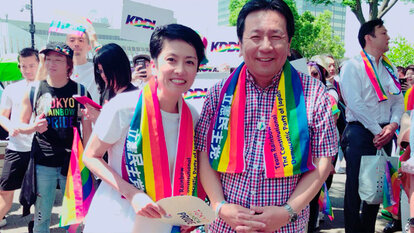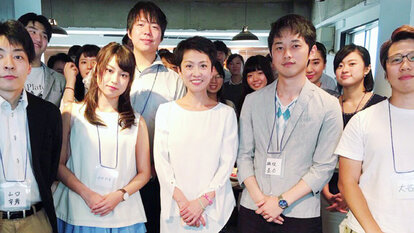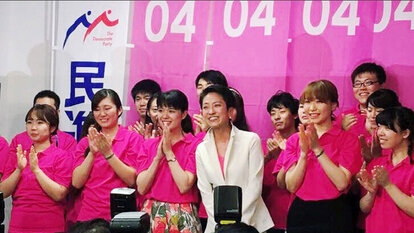Renho Murata: Gender Politics in a Bastion of Patriarchy

The Edo Period (1603 to 1868) of the militaristic and isolationist Tokugawa Shogunate ushered in a long era of peace and prosperity as well as social hegemony” (Encyclopaedia Britannica, n.d.). During this period, Japan institutionalized the “Ie” traditional family where a patriarch presides over multiple generations. The lasting effects of this patriarchal system where men control sociopolitical affairs and have authority over women are still evident to this today (Manga and Gender, n.d.).
The global #MeToo Movement against sexual harassment and assault has made significant inroads in most developed countries and several other developing countries. However, a 28 February 2018 Associated Press article observed, “The #MeToo movement has not caught on in Japan, where speaking out often draws criticism rather than sympathy, even from other women... ‘Conformist pressure in Japan discourages women from speaking out or saying “no” to many things, including unwanted sex,’ said Saori Ikeuchi, a former lawmaker and gender diversity activist” (Voice of America, 2018).

This patriarchy is very much reflected in Japanese politics. Data from the Interparliamentary Union (IPU) ranks Japan as 161st out of 193 countries in terms of women representation in parliament, the lowest among developed countries with only 47 women out of 465 (10.1 percent) in the Diet or House of Representatives and 50 out of 242 (20.7 percent) in the upper chamber (Women in National Parliaments, 2018). “The status of Japanese women in the realm of political and economic empowerment is abysmally low,” Emma Dalton (2016) observed, “(and) this gender inequality in the workforce extends to the world of politics, which continues to be dominated by middle-aged and elderly men” (Dalton, 2016).
But Japan remains as one of the strongest and most stable democracies in the world, aside from being the globe’s third largest economy. This East Asian country with a multi-party parliamentary system is ranked by Freedom House as “1” or “most free” (with 7 as the lowest) in terms of Freedom Rating, Political Rights and Civil Liberties with an aggregate score of 96 (100 being the highest or most free) (Freedom House, 2017).
“Women need to fight lots of invisible pressure in order to get a leg up in this society. I may look strong, but I’m actually weak and shy,” Renho stated during a campaign debate. “But by breaking the glass ceiling myself, I hope women, and the men who support them, will be encouraged to work harder and make Japan a less suffocating place to be” (Jusino, 2016).
Not so many women have risen to political prominence in Japan. Time Magazine mentioned of only three women who have made recent political strides— Yuriko Koike, the first female governor of Tokyo, Defense Minister Tomomi Inada and Renho Murata (Worland, 2016). Born as Hsieh Lien-fang, she is better known by the mononym, Renho. But even amongst Japanese female politicians, Renho is not typical.
As an opposition legislator, Renho belongs to the minority not just in terms of party affiliation (except during the brief period when DPJ held the majority), but also in terms of gender and generation. As if being a woman and her relative youth (she was first elected as legislator while in her thirties) in patriarchal Japan are not challenging enough, an issue used against her is, ironically enough, her own patriarch.
When she was born in 1967 as to a Taiwanese father and a Japanese mother, Japanese law stipulated that a child’s citizenship was passedon by the father. At age 17, she elected to be Japanese when the law was changed in 1985 (Worland, 2016) and allowed her to acquire her mother’s citizenship.
In Japan, people of mixed race are known as hafu, a phonetic play of the word “half” (Chung & Ogura, 2018). “Among Japanese, the perception of pure ethnic background is a big part of belonging to the culture,” according to Al Jazeera which further observed that hafus often faced ridicule and rejection (Saberi, 2015). As a CNN report noted, “despite increasingly progressive attitudes towards race in Japan, foreigners and their hafu chil- dren often live as outsiders” (Chung & Ogura, 2018).
Her having a foreigner father had repeatedly been a bone of contention, even controversy. But quite the contrary, should not this not be to her advantage? Unlike most candidates who were Japanese at birth, Renho chose to be Japanese!—a rather positive soundbyte.

Murata, a journalist and academician, and in 1997, she gave birth to twins.
As a journalist, she had covered important events including natural disasters and politics in Japan and Taiwan and was highly regarded in both countries for her extensive and well-re- searched reportage. Renho covered the historic 2000 presidential elections in Taiwan which saw President Chen Shui-bian and Vice President Anette Lu of the Democratic Progressive Party (DPP) ending more than half a century of the one-party rule of the Koumintang (KMT). It is interesting to note that DPP’s Mark Chen, former Secretary General of the Office of the President of Taiwan and Foreign Minister under President Chen, and Renho are distant relatives.
Renho herself would join a political party that would earn a similar distinction. In 2009, the Democrat Party of Japan ended 54 years of almost uninterrupted rule by the conservative Liberal Democratic Party (LDP) when Naoto Kan became prime minister.
Despite the obstacles, Renho’s political career has been nothing short of meteoric. She is an incumbent Member of the House of Councillors, the upper chamber of the Japanese parliament—a position she first assumed in 2004. She was Minister of State of two portfolios: Government Revitalization (2010-2011; 2011-2012) and Consumer Affairs and Food Safety (2011) under Prime Ministers Naoto Kan and Yoshihiko Noda.

But it was her election as President of the Democrat Party on 1 October 2016 that put her under the spotlight in Japan and in the world stage. Her party presidency received an over- whelming mandate of 503 votes of 849 edging out her rivals by a landslide, veteran lawmaker Seiji Maehara and rookie contender Yuichiro Tamaki, who garnered 230 and 116 points, respec- tively (Jusino, 2016). She was the first woman to lead DPJ and the first mixed-race politician to head a major political party in Japan. And, as leader of the opposition and the second largest political party, being Japan’s first female prime minister became a distinct possibility.
“I will have more discussion within the party about how Japan can promote such values as diversity and coexistence,” she said upon her election as DPJ leader (Worland, 2016). This is not at all surprising for despite being more progressive than the ruling LDP, DPJ can be just as monolithic.
According to the Financial Times, “Renho had sought to cast herself as a voice for Japan’s younger generation. With strong name recognition, she was regarded as the only politician with a chance of reviving the DP” (Harding, 2017).

Fortune enumerated several of her policy agenda. But since the Democrats did not manage to win the majority during her presidency, these did not come into fruition.
Renho has indicated that she wishes to implement policies that will enable more women to participate freely in the workforce and to be better rewarded for their work. She supports some elements of Abenomics—the fiscal policy package being rolled out since 2012 under the Shinzo Abe administration—but she also believes that it has arrived at an impasse and that some changes are needed, especially the policies regarding families and working women. Specifically, she calls for more investment in education, childcare, and other forms of support that will enable families to raise children more easily. At a time when Japan faces a rapidly aging population and a very low birth rate, Renho is keen to create policies that enable couples to feel confident having children without the fear of being excessively financially penalized. She has also proposed revising income tax laws that penalize dual-income families, since the laws have been criticized for encouraging some women to limit their participation in the paid workforce” (Dalton, 2016).

After ten months as party president, Renho stepped down, a move seen as her way of assuming responsibility for the party’s dismal performance in Tokyo’s city assembly elections. “My judgement is that, for now, the best way forward is I step down so that a stronger leadership can take my place. I hope we can move promptly to a leadership election and form a new executive” (Harding, 2017).
Her gracious exit, like her magnanimous victories, is a testimony to her character.
Like Hillary Clinton, Renho Murata has broken the glass ceiling even if the ultimate goal is not achieved. In her 2016 concession speech, the former American Senator and State Secretary stated, “And to all of the little girls who are watching this, never doubt that you are valuable and powerful and deserving of every chance and opportunity in the world to pursue and achieve your own dreams.”

Renho has done something very remarkable, she is a living reminder to all young Japanese women that they can pursue and achieve their dreams, several centuries of patriarchy, notwithstanding.
References
Chung, S., & Ogura, J. (2018, 26 October). What it means to be a mixed-race model in Japan. Retrieved from CNN: https://edition.cnn.com/style/article/rina-fukushi-japanese-hafu-models…
Dalton, E. (2016, October 02). The Rise of Renho Murata Could Advance Other Women in Japan . Retrieved from Fortune: http://fortune.com/2016/10/02/japan-women-renho-murata-equality/
Encyclopaedia Britannica. (n.d.). Tokugawa Period. Retrieved from Encyclopaedia Brittannica: https://www.britannica.com/event/Tokugawa-period
Freedom House. (2017). Freedom in the World 2017. Retrieved from Freedom House: https:// freedomhouse.org/report/freedom-world/2017/japan
Harding, R. (2017, 27 July). Exit of Japan Opposition Leader relieves pressure on Abe. Retrieved from Financial Times: https://www.ft.com/content/a27eeec8-7299-11e7-aca6-c6bd07df1a3c
Jusino, T. (2016, September 21). Feminism Around the World: Renho Makes History In Japan As First Woman and First Mixed-Race Leader Elected to Democratic Party. Retrieved from The Mary Sue: https://www.themarysue.com/feminism-around-the-world-renho-murata-makes…
Manga and Gender. (n.d.). The Rise of Japan as a Patririarchal Society. Retrieved from Manga and Gender: https://mangaandgender.weebly.com/the-rise-of-japan-as-a-patriarchal-so…
Saberi, R. (2015, September 9). Being ‘hafu’ in Japan: Mixed-race people face ridicule, rejection. Retrieved from Aljazeera America: http://america.aljazeera.com/articles/2015/9/9/hafu-in-japan-mixed-race…
Voice of America. (2018, 28 February). In Patriarchal Japan, Saying ‘Me Too’ Can Be Risky for Women. Retrieved from Voice of America: https://www.voanews.com/a/japan-me-too-risks-blame-being-ignored/427385…
Women in National Parliaments. (2018, September 01). Women in Parliaments: World Classification. Retrieved from Women in National Parliaments: http://archive.ipu.org/wmn-e/classif.htm?month=6&year=2018
Worland, J. (2016, 16 September). Four Things to Know About Japan’s Opposition Leader Renho Murata. Retrieved from TIME: http://time.com/4495237/renho-murata-japan-prime-minister/
_______________________
First published on the book, Compelled by Duty, Conscripted by Destiny: Portraits of 16 Asian Women at the Frontline of Democratic Struggle, authored by John Joseph S. Coronel.
In cooperation with the Council of Asian Liberals and Democrats (www.cald.org)